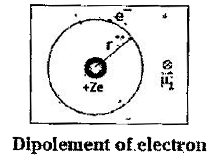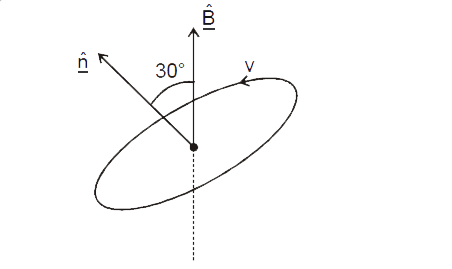Derive an expression for the magnetic dipole moment of a revolving electron .
Let an electron (e) be revolving around the nucleus in a circular path of radius .r.
Current 1= number of electrons flowing per second.
Let time period of revolution of electron =T
Then current l=eTBut.T=2πrυ  Dipolement of electron
Dipolement of electron
∴l=ev/2πr
Magnetic moment is associated with a circulating current in a loop or closed path.
Magnetic moment (M)=lA.
Here magnetic moment is represented by μr
∴μr=IA=lπr2=eυr2
The direction of this magnetic moment is into the plane of the paper.
Similar Questions
Knowledge Check
Maghnetic dipole moment of revolving electron is
Aevr2Befπr2Cboth 'a' and 'b'Dneither 'a' not 'b'Magnetic dipole moment of revolving electron is
AeL2mBe2mCe2MLDemL
Deduce an expression for the magnetic dipole moment of an electron orbiting around the central nucleus.
View SolutionIn a hydrogen atom, an electron carrying charge 'e' revolves in an orbit of radius 'r' with speed 'v'. Obtain an expression for the magnitude of magnetic moment of a revolving electron.
View SolutionAn electron in the ground state of hydrogen atom is revolving in anti-clockwise direction in the circular orbit of radius R as shown in figure.

Obtain an expression for the orbital magnetic dipole moment of the electron.
View SolutionDerive an expression for the magnetic moment (→μ) of an electron revolving around the nucleus in termsof its angular momentum (→l). What is the direction of the magnetic moment of the electron with respect to its angular momentum?
View SolutionDerive an expression for the magnetic moment (→μ) of an electron revolving around the nucleus in termsof its angular momentum (→l). What is the direction of the magnetic moment of the electron with respect to its angular momentum?
View SolutionDerive an expression for the magnetic moment →μ of an electron revolving around the nucleus in terms of its angular momentum →l. What is the direction of the magnetic moment of the electron with respect to its angular momentum?
View Solution
